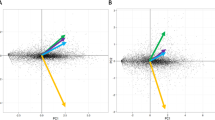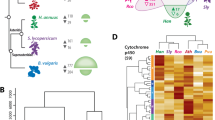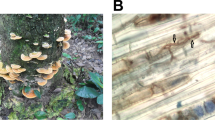Abstract
Hybrid species of fungal pathogens that infect wild and cultivated plants are emerging with new virulence and host ranges, posing a threat to agriculture and forestry1. Here we show that the virulence of hybrid species of the basidiomycete fungus Heterobasidion annosum (Fr) Bref, a causal agent of root and butt rot in conifers and one of the most economically important forest pathogens, is controlled by their mitochondrial genome. Our results indicate that cooperation between organelles that contain genetic information may influence the phenotype of hybrid phytopathogens.
Similar content being viewed by others
Main
Among fungal plant pathogens, species hybrids have been discovered in Melampsora2,3, Phytophthora4,5,6, Ophiostoma7 and Heterobasidion8. In North America there are two intersterile groups of H. annosum that correspond to species with overlapping morphological characters and different ecological niches: the 'S' group infects Abies spp. and Tsuga spp.9, whereas the 'P' group has Pinus spp. as its main hosts9. So far, only one natural S–P hybrid has been found8 — this isolate is less virulent than either of its progenitors to their 'adapted' host plant species but not to a universal host10.
We articially created four S–P hybrid heterokaryons (fungal mycelia that contain dissimilar nuclei), one S–S heterokaryon and one P–P heterokaryon from four North American homokaryotic H. annosum isolates (containing one nuclear type each; provided by T. E. Chase) and determined the severity of their effects on pine seedlings (Table 1).
We analysed the virulence of the homokaryons and heterokaryons in vitro by visually scoring dead or live pine seedlings daily for 20 days11. We observed no significant difference in virulence between homokaryons and heterokaryons of either the S or P intersterility groups (P < 0.05, χ2 test). This is consistent with earlier results suggesting that heterokaryosis of H. annosum is not required for virulence12.
We scored S–P hybrids as having either low or high virulence to pine, which is characteristic of the S and P groups, respectively (Table 1). Isolates AO 9 and AO 13 did not differ significantly in virulence from P isolates, but were significantly different from isolates AO 8 and AO 12, and from S isolates (P < 0.05, χ2). Neither AO 8 nor AO 12 differed significantly from S isolates, but they were different from P isolates (P < 0.05, χ2). If the virulence of a H. annosum hybrid were solely controlled by nuclear virulence genes or by avirulence genes, then all S–P hybrids should show either the high or low virulence that characterizes the respective intersterility groups.
Homokaryotic H. annosum S and P isolates differed in the size of an intron in the gene that encodes the large-subunit RNA of mitochondrial ribosomes, as revealed by amplification with the ML5–ML6 primer pair8 (Table 1). The mitochondria of the hybrid isolates AO 8 and AO 12 were from the S homokaryon, whereas those of AO 9 and AO 13 were of P origin (Table 1). None of the S–P hybrids possessed both types of mitochondrion, showing that mitochondrial transmission was uniparental.
There was a perfect correlation between the mitochondrial type acquired by the hybrids and their virulence (Table 1; Fig. 1). Hybrids with mitochondria of P origin had similar virulence to P homokaryotic progenitors, whereas the virulence of hybrids with S mitochondria resembled that of S homokaryons. To our knowledge, this is the first example of mitochondrial control of virulence in species-hybrid plant pathogens, although mitochondria are thought to be important in host specialization for Phytophthora nicotianae × P. cactorum hybrids5.
Virulence of hybrids is controlled by the mitochondrion (represented by ellipses) rather than the nucleus (circles). Blue denotes genomic inheritance from the P group, red from the S group. Hybrids with mitochondria of S origin do not kill the pine seedling (top), in contrast to hybrid mycelia with mitochondria of P origin (bottom).
What is the source of this correlation between mitochondrial origin and the virulence of pathogenic fungal hybrids? It may be that the mitochondrial genome itself encodes factors that determine the virulence of hybrids, or that interplay between the organism's mitochondrial and nuclear genomes gives rise to a mitochondrially determined phenotype in hybrids.
References
Brasier, C. Nature 405, 134–135 (2000).
Spiers, A. G. & Hopcroft, D. H. Mycol. Res. 98, 889–903 (1994).
Newcombe, G., Stirling, B., McDonald, S. & Bradshaw, H. D. Jr Mycol. Res. 104, 261–274 (2000).
Éresk, T., English, J. T. & Schoelz, J. E. Phytopathology 85, 1343–1347 (1995).
Man in't Veld, W. A. et al. Phytopathology 88, 922–929 (1998).
Brasier, C. M., Cooke, D. E. L. & Duncan, J. M. Proc. Natl Acad. Sci. USA 96, 5878–5883 (1999).
Brasier, C. M., Kirk, S. A., Pipe, N. D. & Buck, K. W. Mycol. Res. 102, 45–57 (1998).
Garbelotto, M., Ratcliff, A., Bruns, T. D., Cobb, F. W. & Otrosina, W. J. Phytopathology 86, 543–551 (1996).
Korhonen, K. & Stenlid, J. in Heterobasidion annosum: Biology, Ecology, Impact and Control (eds Woodward, S., Stenlid, J., Karjalainen, R. & Hüttermann, A.) 43–70 (CAB International, Wallingford, 1998).
Garbelotto, M., Popenuck, T., Ratcliff, A., Cobb, F. W. & Bruns, T. D. Phytopathology 86 (suppl.), 28–29 (1996).
Sharma, P., Börja, D., Stougaard, P. & Lönneborg, A. Physiol. Mol. Plant Pathol. 43, 57–67 (1993).
Garbelotto, M. et al. Mycologia 89, 92–102 (1997).
Author information
Authors and Affiliations
Corresponding author
Rights and permissions
About this article
Cite this article
Olson, Å., Stenlid, J. Mitochondrial control of fungal hybrid virulence. Nature 411, 438 (2001). https://doi.org/10.1038/35078147
Issue Date:
DOI: https://doi.org/10.1038/35078147
This article is cited by
-
Interspecific hybridization as a driver of fungal evolution and adaptation
Nature Reviews Microbiology (2021)
-
First characterization of the complete mitochondrial genome of fungal plant-pathogen Monilinia laxa which represents the mobile intron rich structure
Scientific Reports (2020)
-
The conifer root rot pathogens Heterobasidion irregulare and Heterobasidion occidentale employ different strategies to infect Norway spruce
Scientific Reports (2020)
-
Mitonuclear interactions may contribute to fitness of fungal hybrids
Scientific Reports (2018)
-
Evolution and genome architecture in fungal plant pathogens
Nature Reviews Microbiology (2017)
Comments
By submitting a comment you agree to abide by our Terms and Community Guidelines. If you find something abusive or that does not comply with our terms or guidelines please flag it as inappropriate.




